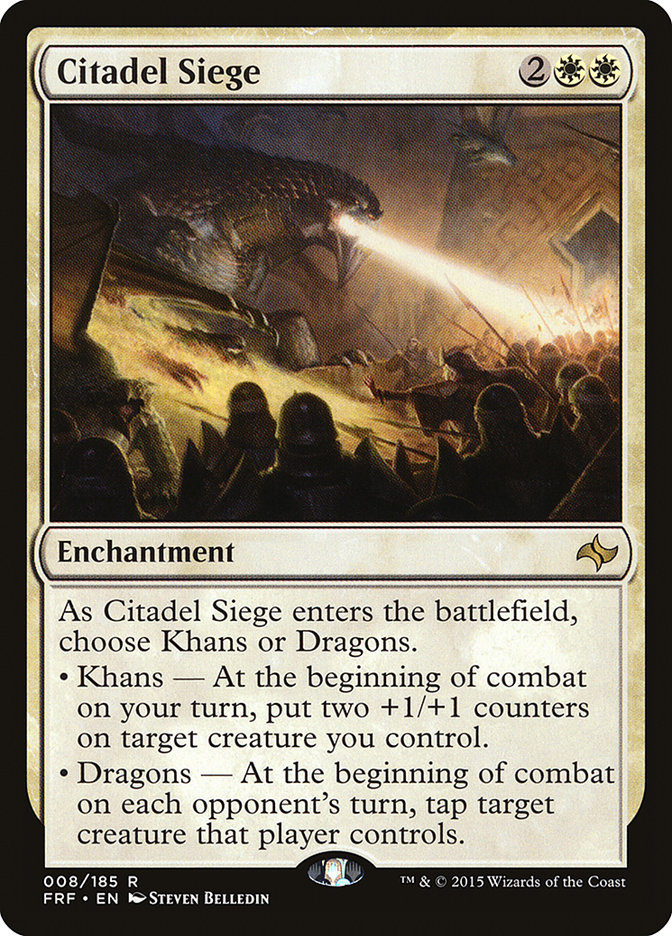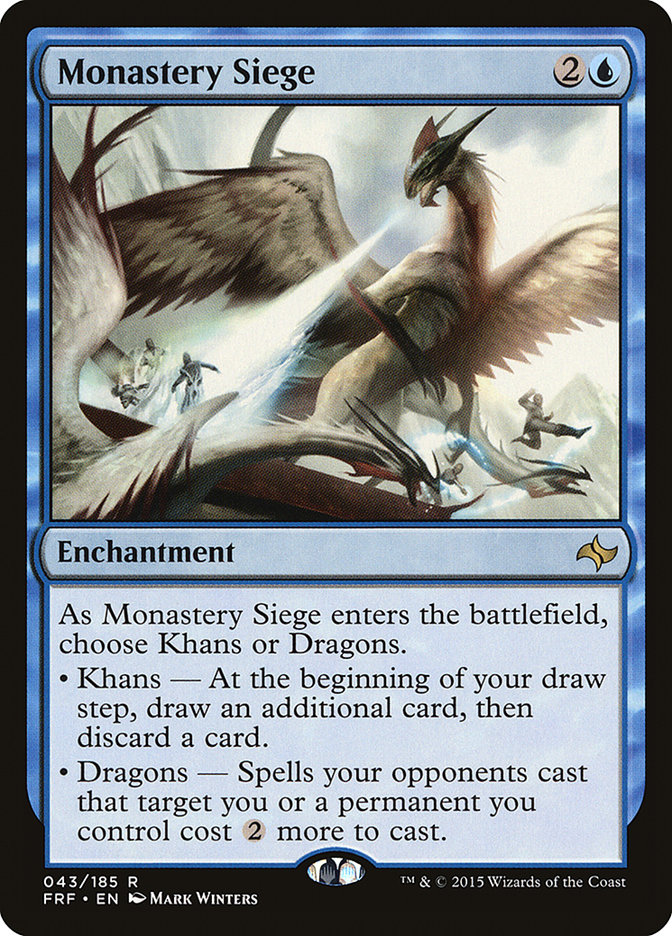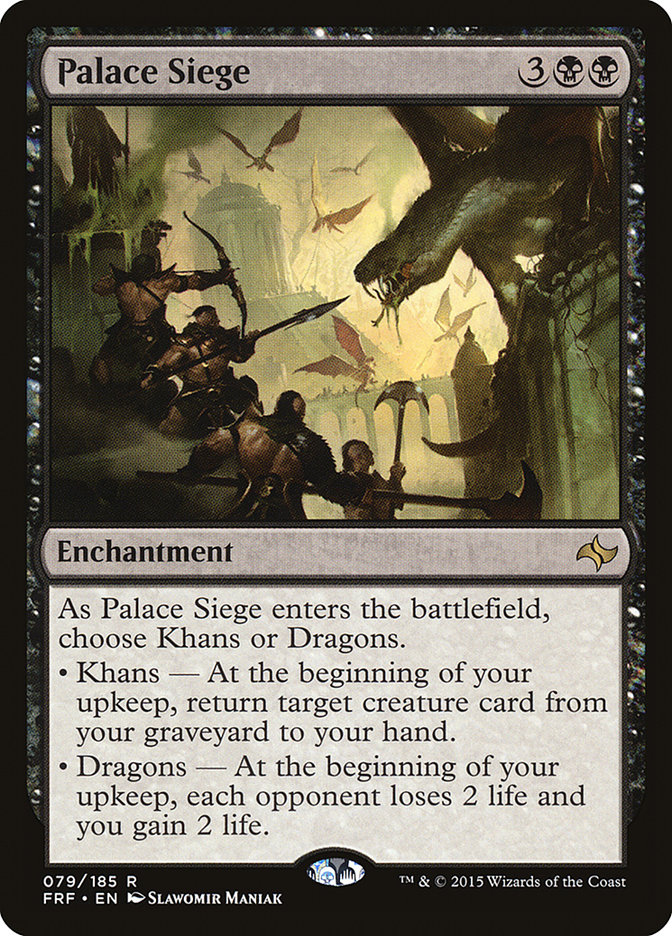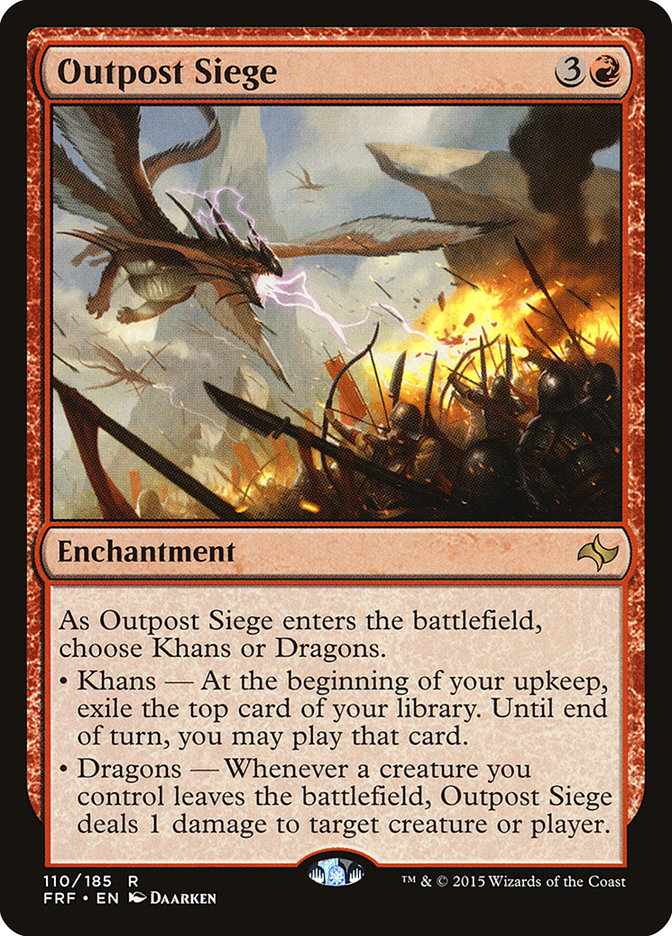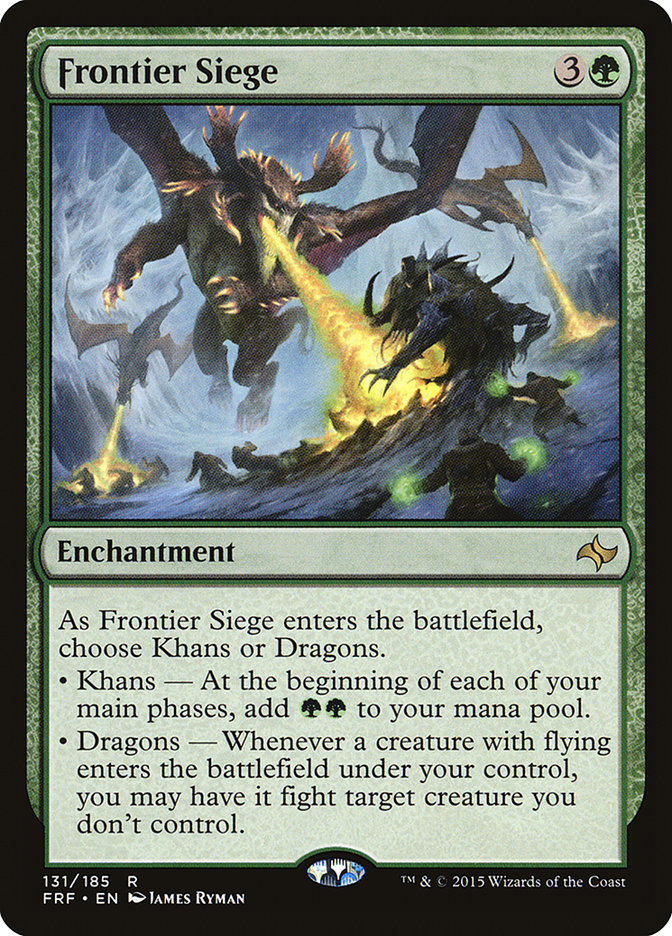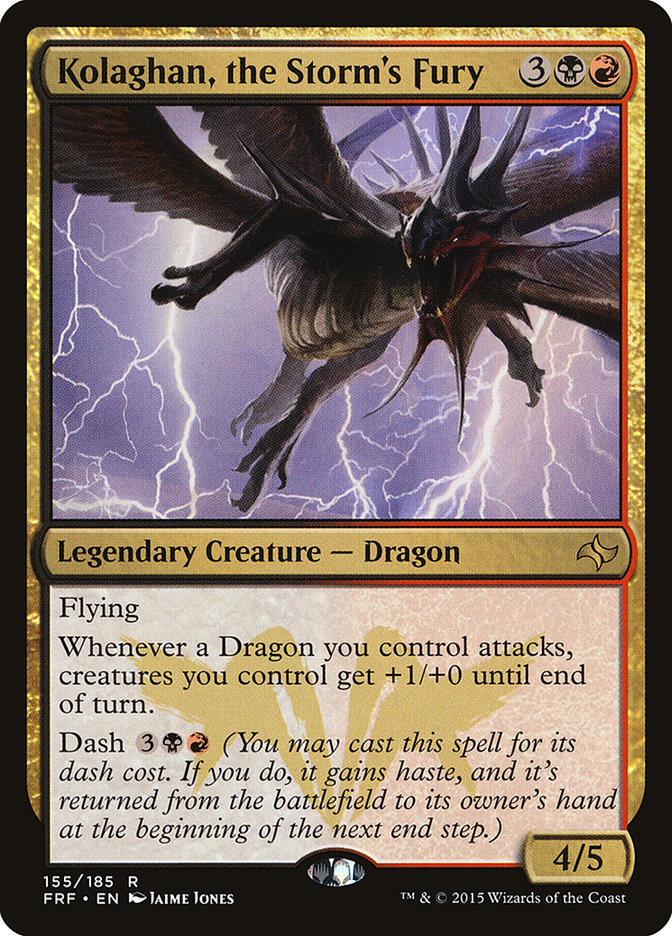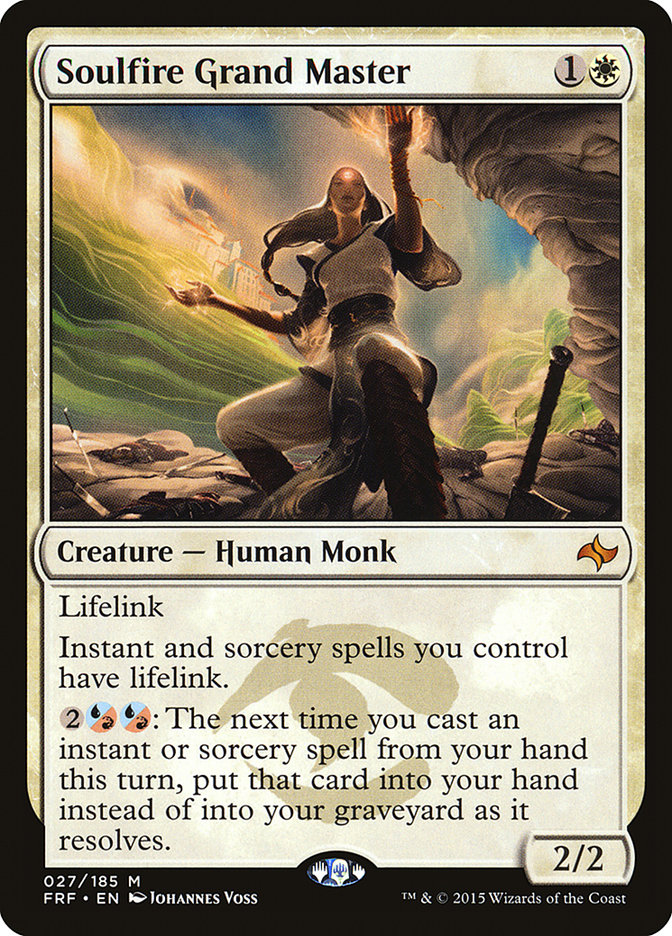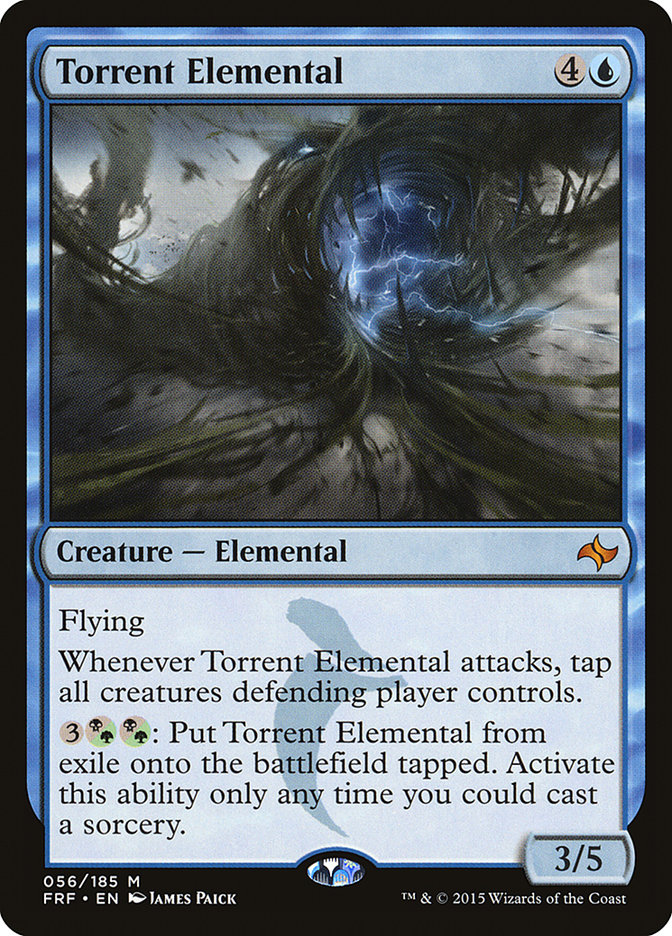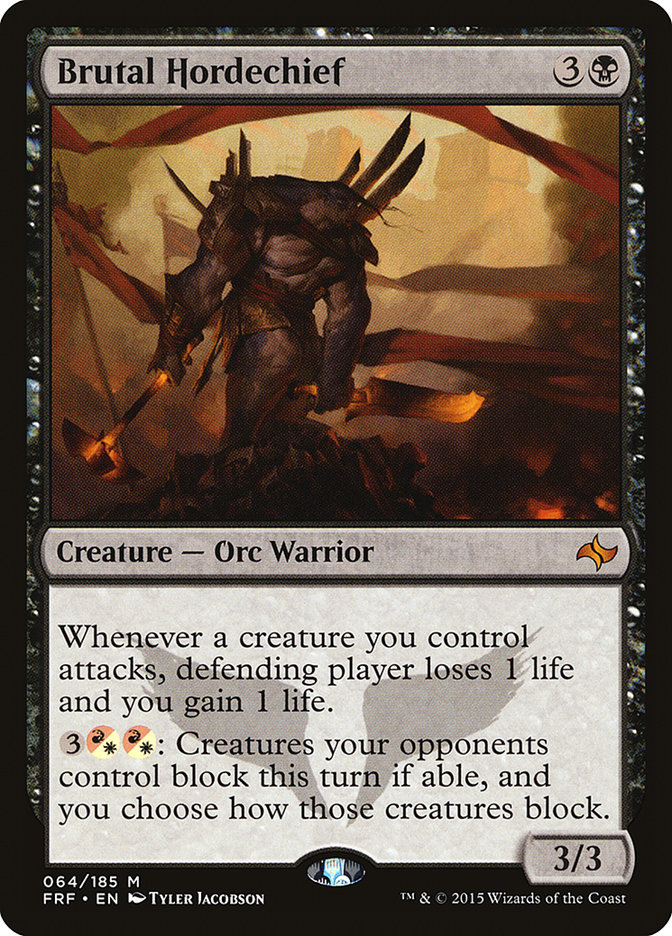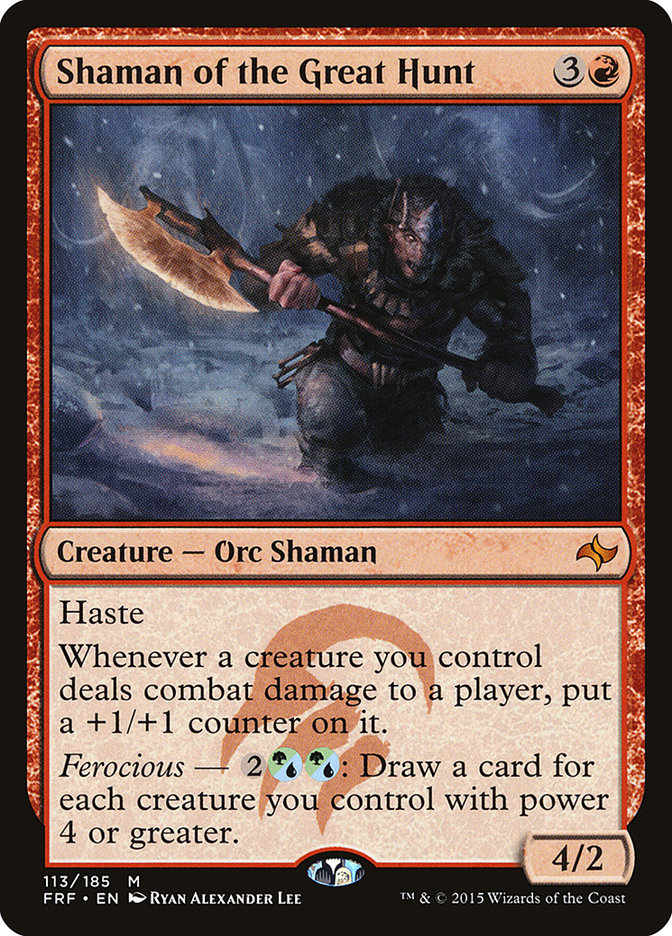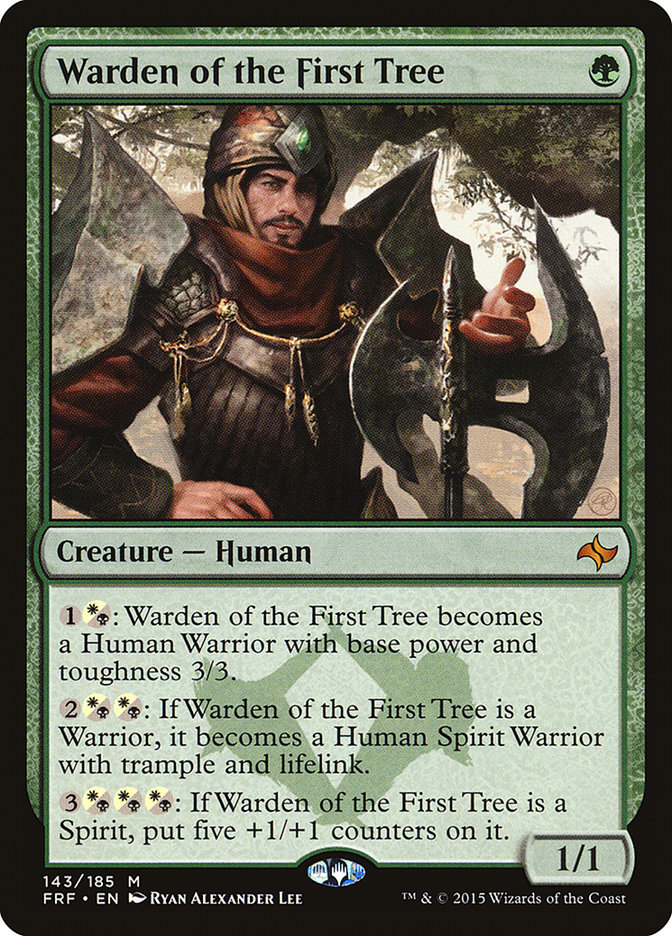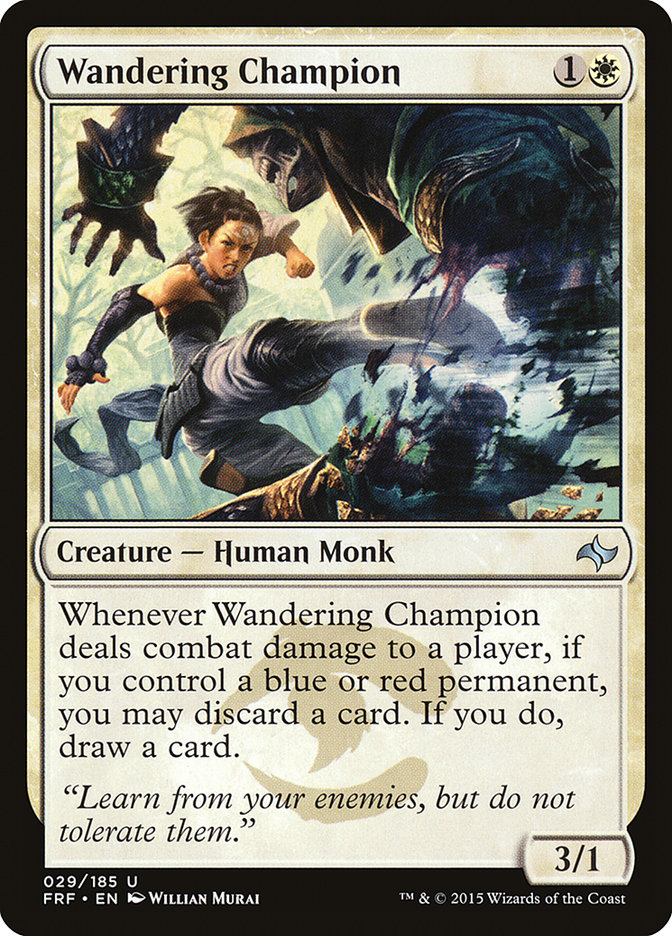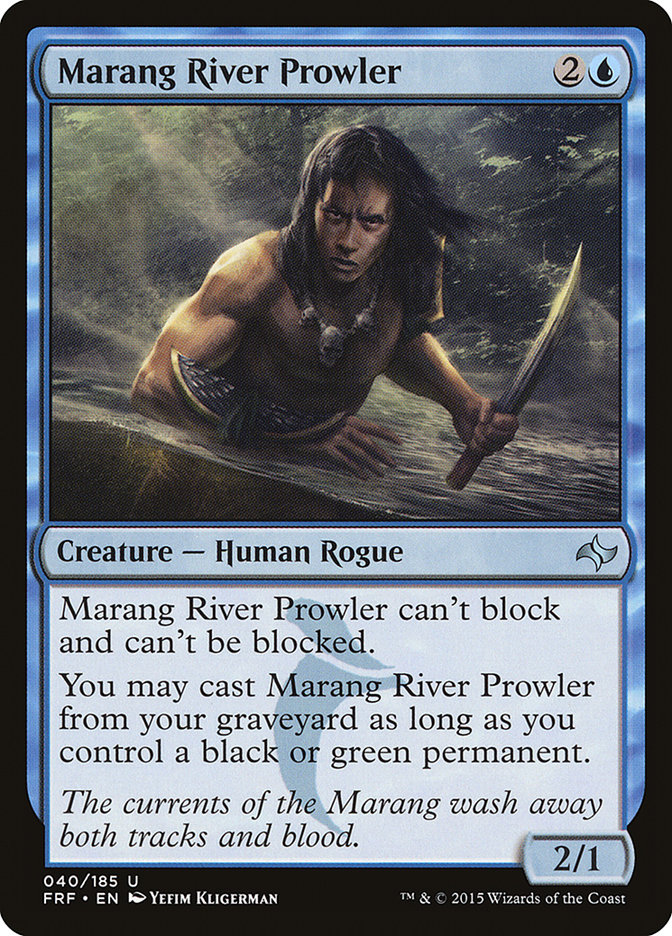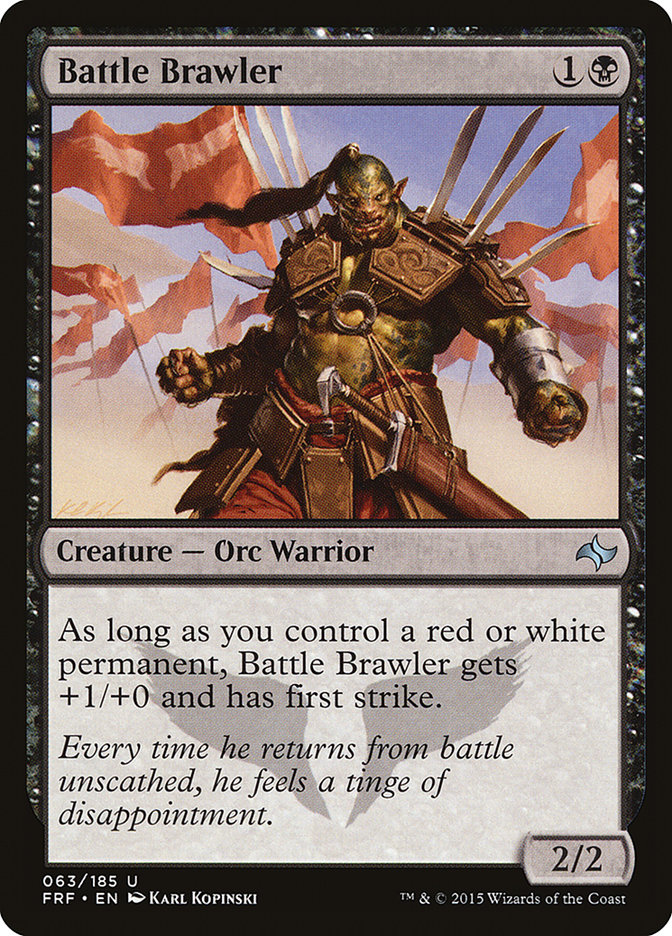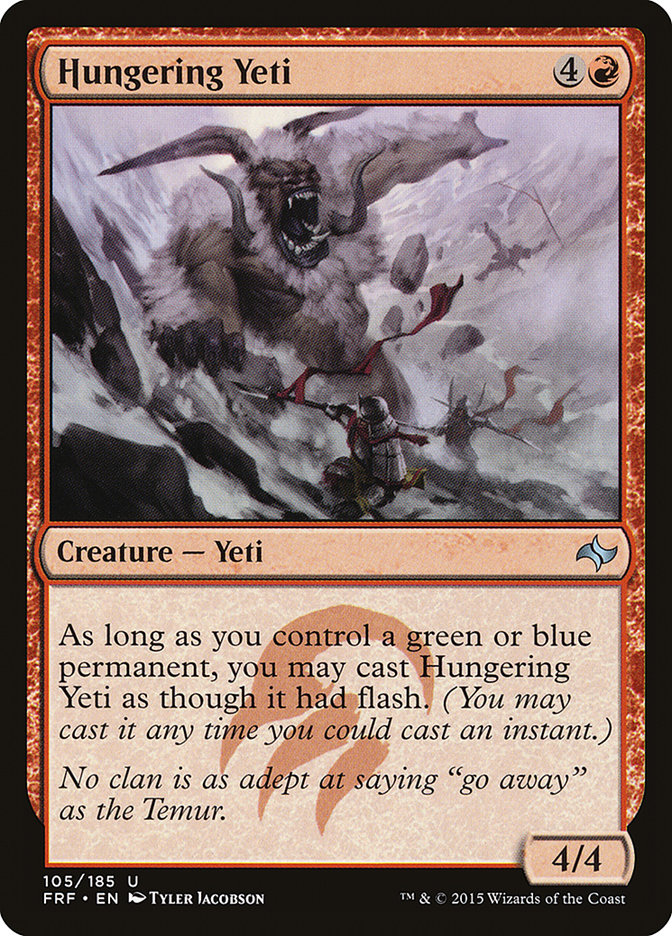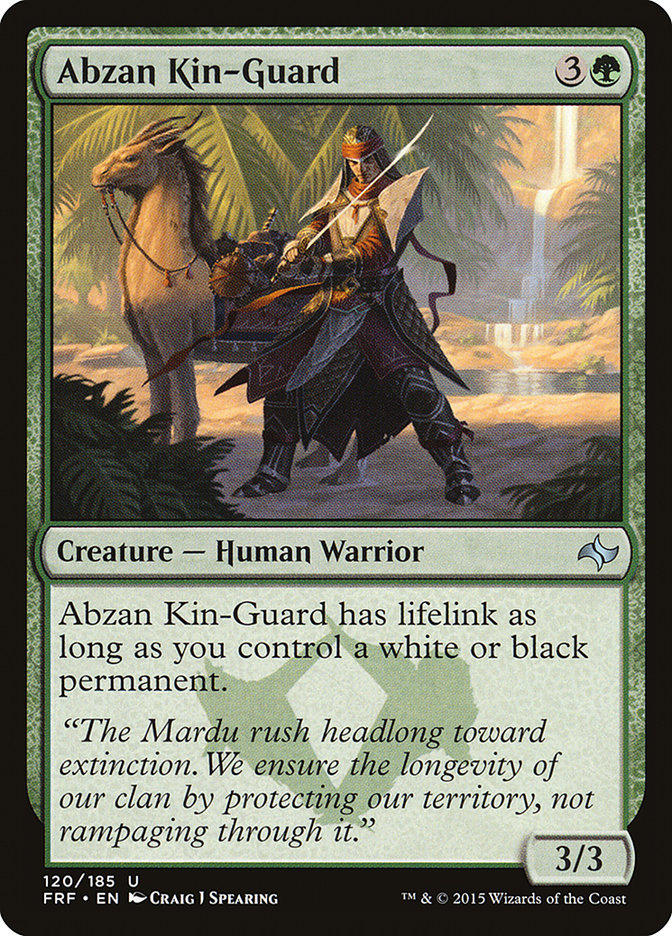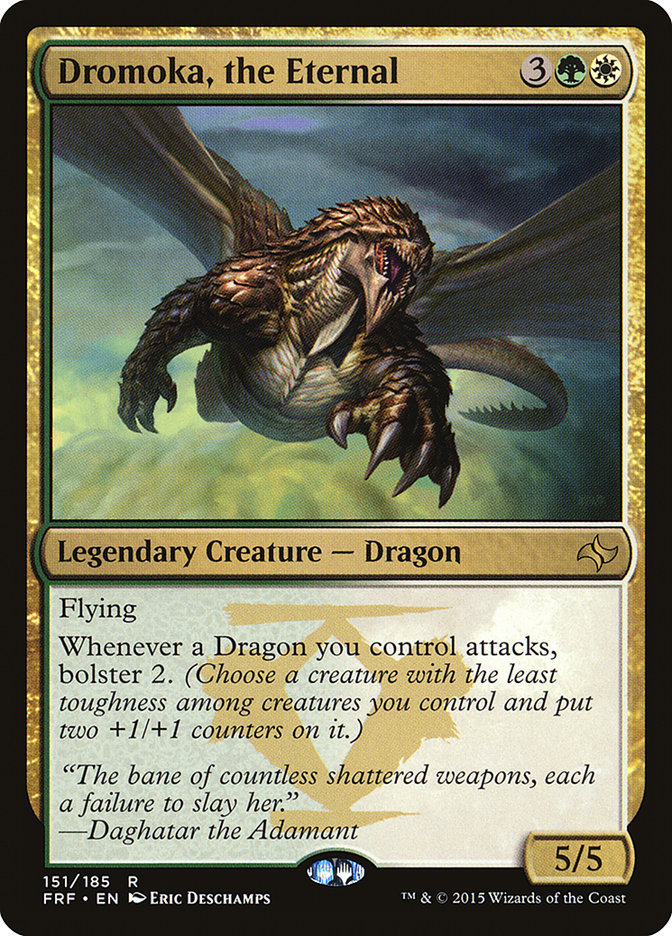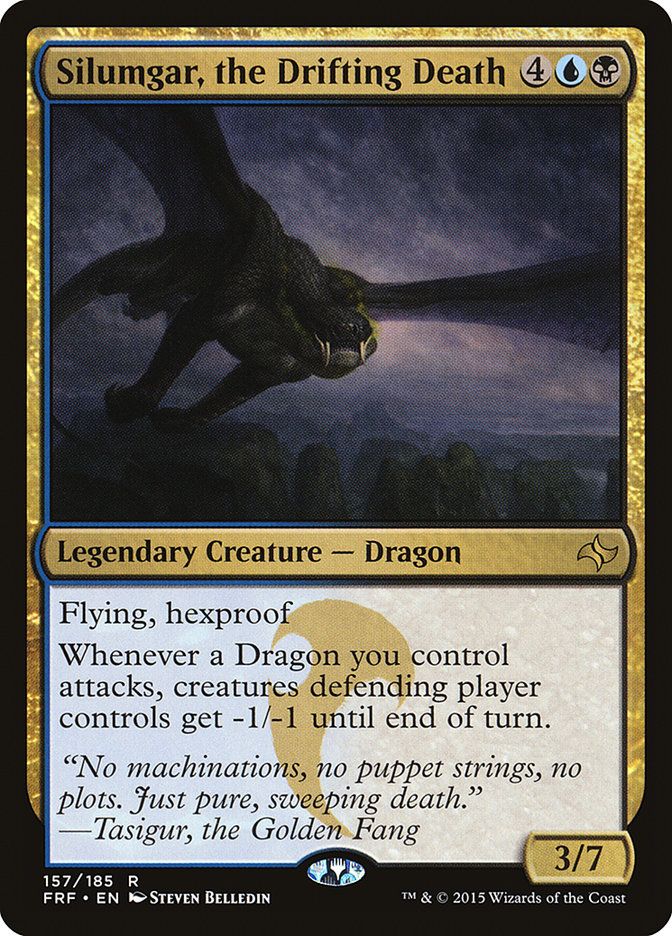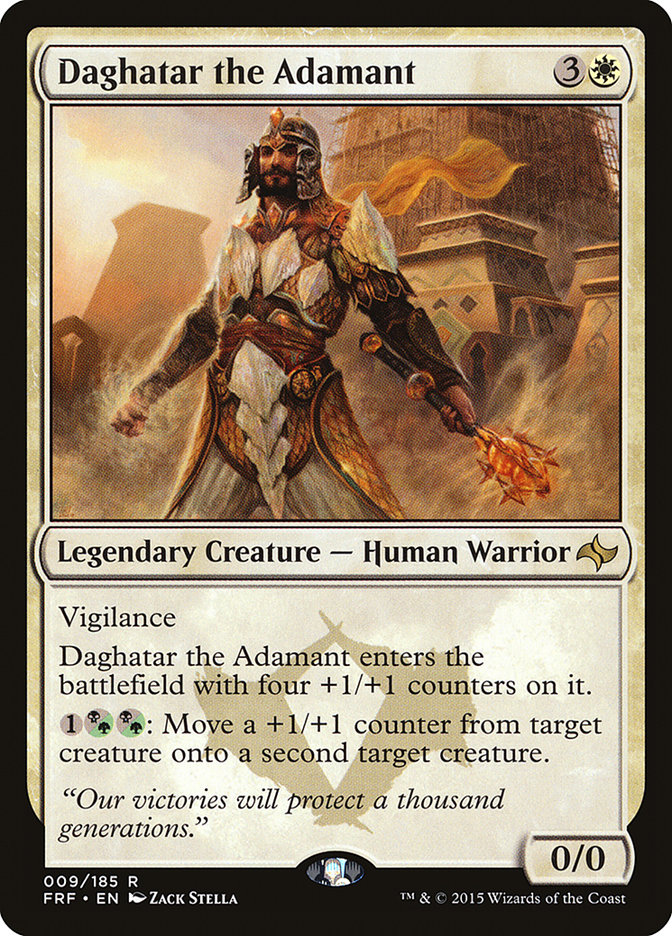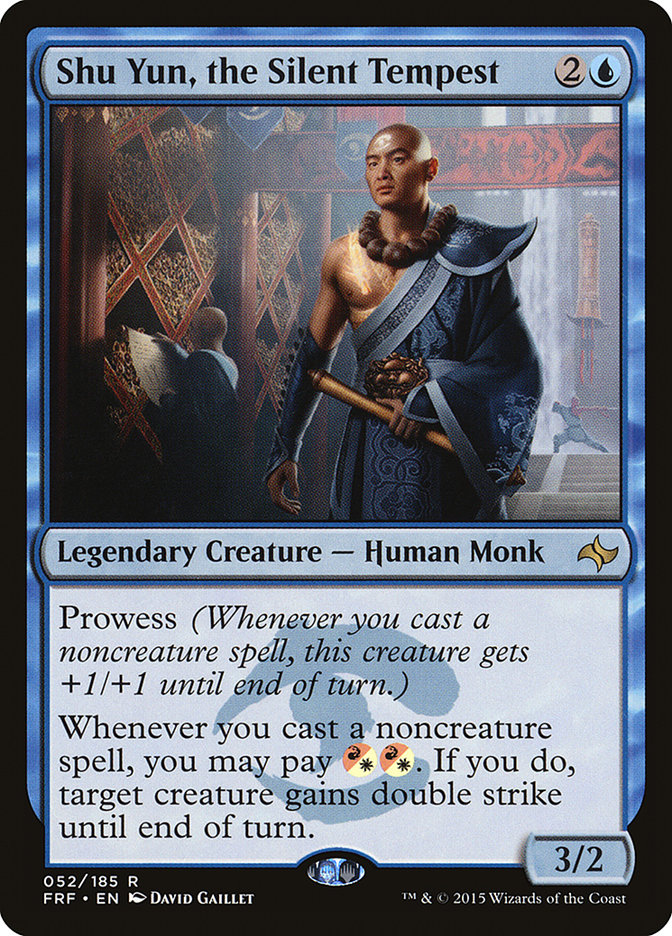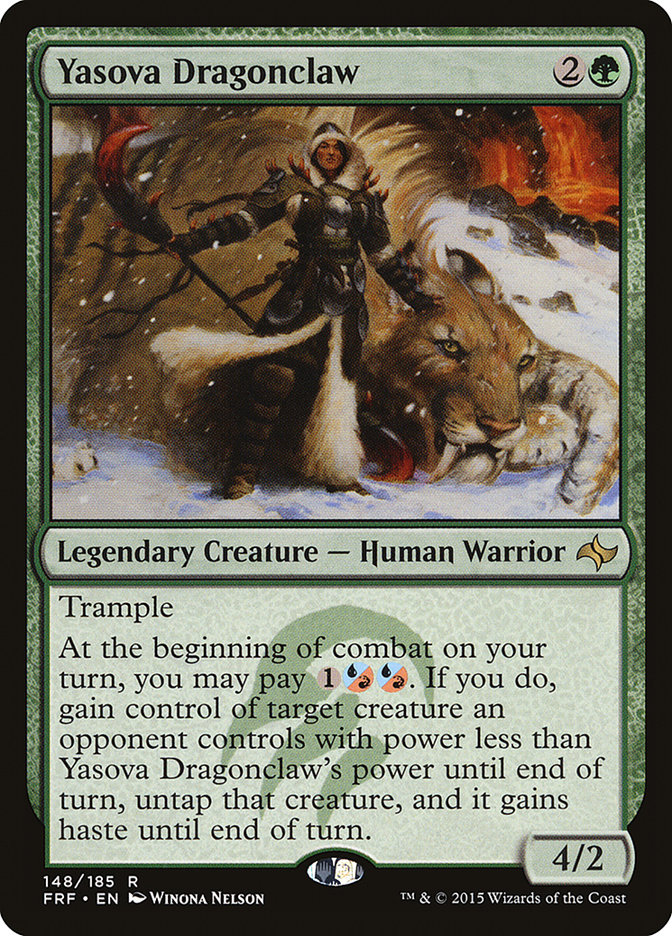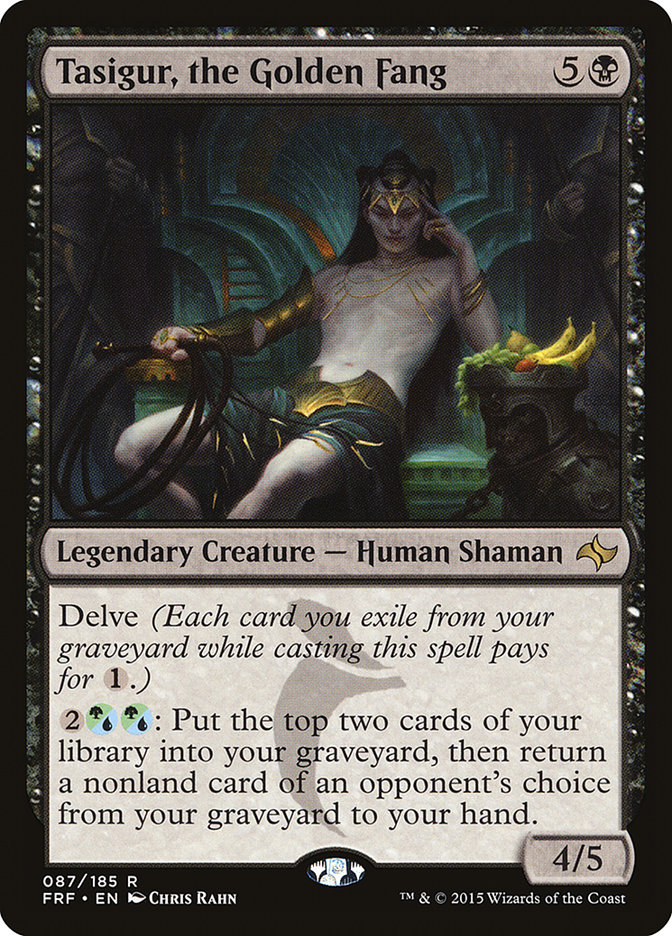More and more it seems like Magic design involves cycles. They add a sense of completeness, show off what the different colors are doing with an easy
comparison, and often help keep things in balance. If Abzan has a Siege Rhino, Mardu has a Butcher of the Horde, Temur has Savage Knuckleblade, and Jeskai
has Mantis Rider; everything is fighting with the same weapons. Of course, sometimes there is a Rakshasa Vizer in the cycle-or a Jeskai Ascendancy–and
everything is thrown off, but for the most part, everyone is on the same level.
With a bit under half the set spoiled, Fate Reforged has revealed a significant number of cycles to examine for Constructed. How does each member of these
stack up to their counterparts? Which ones will rise to the top or sink to the bottom?
The Sieges
All of the Sieges appear to be right on the borderline of Standard playability. I’m assuming they were supposed to be on par with the Ascendancies, but we
all know how that one went.
I’m not too interested in the Khans trigger, more so the Dragons one.
The idea of a removal spell you can cast and have stick around through a sweeper to force your opponent to overextend again is definitely enticing. Given
the current Standard metagame of army-in-a-can threats like Wingmate Roc, planeswalkers, Hordeling Outburst, and Hornet Queens, I’m skeptical it will find
a home; however, on the days the format is Anafenzas and Siege Rhinos, it will be excellent. It’s way better than the previous Martial Law, as the trigger
happens on the first turn the card is in play, but I’m not sure the format is right for it.
It’s kind of awkward that the best place for the Dragons ability is a control deck where the Khans trigger isn’t useful in a typically creatureless
scenario, locking the card into a single mode. The control application also may be all moot because of the anti-synergy with Perilous Vault and because
four-mana removal spells are clunky on a good day.
Maybe this sees play as the expensive removal spell in a midrange deck that can turn into a way to win board stalls, but that feels like wishful thinking.
I don’t think what this card is doing is what the format is about right now.
Verdict: Unique enough to potentially see play but hindered by the mana cost and scale of the effect given the cards it is facing down.
The Khans side of this card has similar issues to Sultai Ascendancy. Costing a card and three mana for no immediate effect and no future return of
a full card is not really what any deck is looking for. Aggressive decks don’t want to spend a full turn, and control decks don’t want to spend a full
card.
The Dragons side is similarly mediocre. You are spending a card with the premise of making your opponent less mana efficient, but it takes them two removal
spells for your investment to be returned in their spent mana.
Verdict: If this card sees play, I will be shocked.
The Khans trigger reminds me of Oversold Cemetery, a card which brings back some fond memories. Today’s graveyard decks have more powerful tools. Soul of
Innistrad is a direct comparison which doesn’t require you invest a card and wins the game without help.
I initially thought that less self-mill focused decks might want this card as something that can sit around through sweepers and provide a similar effect.
This isn’t unique, as the same anti-sweeper power is readily available with planeswalkers. This card is competing with Liliana Vess as a five-mana card
advantage engine in the same color. Of course, Liliana and other planeswalkers are attackable, but if your opponent is a matchup where you are playing from
behind, slow engines like this aren’t really what you want. I’m not seeing this as standing up to the power levels of the other card advantage engine
options available.
The Dragon side is way too expensive as a threat. The equivalent threats in Standard all kill far faster and even gain life faster if you want to (Wingmate
Roc).
Verdict: Overcosted. Maybe once Magic 2015 rotates out there will be a hole for it to fill, but not right now.
The Khans side seems quite acceptable here. I’ve often had issues with Chandra, Pyromaster dying to attackers in various decks, and I’ve played many
versions of the same four-mana, draw two cards a turn effect across many formats.
The Dragons side notably says “leaves the battlefield,” meaning it triggers off Flicker effects, creatures being exiled, or bouncing creatures to hand.
Norin says hi, but I’m not sure how many other ways you can get cute with this.
I’m not excited about the Dragons effect for this cost, but it self-synergizes with the Khans half. Get far enough ahead with irrelevant creatures on
board, then play another copy and force a lethal board. This midrangey format is also one that has proven conducive to tokens strategies where the Boggart
Shenanigans/Blood Artist style effect will be at its best even if it is overcosted.
Expect this card to be paired with Hordeling Outburst. Even beyond the obvious “this is good with tokens” aspect of the card, those decks are better at
playing a longer game than more aggressive red decks and can actually get somewhere riding the card advantage from the Khans trigger.
Verdict: Unlikely to be the core of an archetype but strong enough to make the cut.
The only reason I see this card not seeing play is because Jeskai Ascendancy plus Treasure Cruise might just be a better version of what it is doing.
The Khans side here is very good. Explosive Vegetation was a Constructed-playable card. Ranger’s Path also saw light play towards the start of
Innistrad/Return to Ravnica Standard. A four-mana investment to ramp two mana is definitely in range of playable. This card gives you the mana trigger
twice a turn, so the Ranger’s Path example is a low-end estimate given the right mana sink. Frontier Siege also curves directly into Hornet Queen, the
premier ramp threat of the format. Looking at new high end options there is a bit of a nonbo with how Frontier Siege is exiled by Ugin, the Spirit Dragon’s
–X ability, but presumably once that card enters play you should be gaining enough of an advantage with that ability that losing the mana shouldn’t be an
issue.
What about the Dragons side? The first thing everyone has thought of appears to be “fight my four 1/1 flying deathtouch Insect tokens with your creatures”
to make Hornet Queen into Plague Wind, which is odd considering the card literally tells you what the intent is right there.
As for the Dragons side…
I’m especially interested in Kolaghan, the Storm’s Fury here. The dash mechanic’s “Return this to owner’s hand at end of turn” drawback can be abused to
build recurring removal. The mana doesn’t make a lot of sense on the surface (shard mana in a wedge format and an enchantment that adds GG in a Jund deck),
and I’m not sure 4/5 fight triggers are good in a format of Siege Rhinos, but the combination is powerful and worth exploring.
The immediate role this card will play is supplying Green Devotion with a backup way to generate critical amounts of mana. It’s also an enchantment that
triggers both Doomwake Giant and Eidolon of Blossoms when G/B Constellation was already the most successful secondary engine for the deck. The amount the
Siege provides as a single card is pretty absurd compared to the similar cards that previously existed. Multiple mana for a single card, survives most
removal unlike Karametra’s Acolyte, and extra copies do things when the mana isn’t needed.
Verdict: By far the best Siege. Immediately going to have an impact in an existing archetype, and easily playable beyond that shell.
Hybrid Activation Mythics
The next cycle is five non-legendary, mono-color mythics with a hybrid activated ability that covers the other two colors of the clan the mythic belongs
to. All of these have clearly been pushed, both to fit the mythic rarity in terms of flashy uniqueness and in terms of power level.
People have been hyping this card alongside Stoke the Flames and other aggressive options.
I’m unimpressed.
2/2 lifelink is actively bad as a creature in this Standard format. 3/3 for two is pretty much the minimum given that Courser of Kruphix and
Sylvan Caryatid are the things you have to attack into. The ability is also far too costly to reasonably cycle through any non-Stoke the Flames burn
spells.
Where I actually think this card will see play is in more controlling decks. The ability to set up a counterspell with buyback of 2(U/R)(U/R) in the
lategame actually seems like a dominating play worth playing a Grizzly Bear for, and the lifelink as a stabilizing effect matters a lot more.
These decks don’t have to be pure control. They could even still be Stoke the Flames and Hordeling Outburst decks. Just be aware that this card pushes you
towards a long game, and playing it as a short game Guildmage style effect will leave you sorely disappointed.
Verdict: This is not an aggressive two-drop. Don’t try to make it one.
3/5. Tap all creatures defending players control.
One Elspeth, Sun’s Champion hate card found.
Beyond that, this card seems pretty good. There are many decks in Standard that position themselves to create clogged defensive boardstates that quickly
turn around, and this card eliminates the first half of that. It also immediately recovers from common removal spells like Banishing Light, Chained to the
Rocks, and Abzan Charm.
It even draws you an extra card when you delve it to Treasure Cruise! How can you pass up that value?
The only drawback is going to be finding a U/G or U/B home for the card where you want to be aggressive enough to utilize it. My initial guess is I’m
overthinking this and that simply playing this alongside Sidisi and Murderous Cut is good enough, especially because Torrent Elemental can naturally block
a Siege Rhino.
Verdict: Quite strong, but mostly for the body and trigger; less for the recursion.
People are immediately comparing this card to Hellrider. I know a thing or two about Hellrider, and this is not Hellrider.
Hellrider was a virtual four power of haste even in the empty board scenario. By simply not having haste, this card is vastly different.
I think Josh Mcclain had this right in his Quick Questions answer last weekend at Grand Prix Denver.
You want to play this card with Hordeling Outburst for multiple reasons. Beyond the obvious interaction of the one drain per attacker trigger being better
with more creatures, the hybrid activation also exploits having disposable attackers. While it does force their creatures to block so it isn’t a true
Falter, you have the option of throwing all of their available blockers on a single attacker. For example, a 1/1 Goblin token.
In this sense, Brutal Hordechief is more of a Pyreheart Wolf.
I would start with the usual Raise the Alarm, Seeker of the Way, Hordeling Outburst, Goblin Rabblemaster shell and only lightly splash black for
Hordechief. Of course, this is basically the same shell we’ve seen Butcher of the Horde in, but I think it’s worth trying the more aggressive, less
standalone option to see where it goes.
Verdict: Overlap with Butcher of the Horde is an issue, but it may prove better in a dedicated tokens strategy.
Now this is a Hellrider.
4/2 isn’t the best size for a creature in Courser of Kruphix’s format, but I’m not going to pass up a four-power haste creature just because of that one
interaction. Especially if after a single hit it becomes a 5/3 and runs right through a Courser. And especially if it pumps your Rattleclaw Mystics and
Elvish Mystics into relevant bodies if they can connect. And especially if it punishes your opponent for having to play defensively by
letting you spend the time drawing a bunch of extra cards.
On that last note: one of the aspects of the Temur decks that needed some work was what it did with tons of mana. You are playing thirty or more mana
sources, and most of your creatures are slotted for their efficiency. You run into scenarios where you have seven or eight mana in play and not a lot to do
with it. The deck as is plays quite a few mana sinks already between Savage Knuckleblade, Polukranos, World Eater, Crater’s Claws, and Boon Satyr, but
another on this power level is always welcome.
Verdict: Probably the best of the cards from this cycle. Unsurprising when you consider it’s the one that says draw a card.
This is not Figure of Destiny.
Figure of Destiny was a 4/4 in a format of Agony Warp and Firespout.
Warden of the First Tree is a 3/3 in a format of Courser of Kruphix, Siege Rhino, and Lightning Strike.
Figure of Destiny costs one mana to level up on turn 2, allowing you to play Windbrisk Heights on curve. Warden of the First Tree costs two mana on turn 2,
ensuring you take a bunch of pain or have to play your tapped land on a later turn and delay the much more powerful three- through five-drop threats this
format offers.
Don’t be tricked by the repeating ultimate. You didn’t ultimate Figure of Destiny much to begin with, and it was almost always enough if you did.
Figure of Destiny was the only card of its type in the format. This has to compete with Fleecemane Lion, which is arguably better than this even when both
have been fully activated, and Rakshasa Deathdealer, which is harder to kill.
The reason this card will see play is the fact that you can attack with a 3/3 on turn 2 if you have it in your opener. That’s it.
Verdict: Drawing the comparison to Figure isn’t remotely close. Warden of the First Tree is still an acceptable card, but it isn’t what people think it
will be.
Wedge Bonus Uncommons
Previewed as a Limited cycle
, these creatures that gain abilities when you control a wedge-aligned permanent aren’t too far off of Constructed play.
3/1 doesn’t line up well with Courser of Kruphix or Hordeling Outburst, but Rummaging on a hit is actually way more powerful than it looks. This is
especially true if you are chaining tempo answers into each other with the Rummage getting you closer to the next one each time the Champion connects. I
don’t think now is the time for this card, but if new tempo-oriented spells get printed, I would watch this card. Also note that Aqueous Form both forces
this card through and enables the trigger, which might imply it fits in some tempo/heroic hybrid alongside some of the more powerful heroic cards like
Fabled Hero.
Verdict: Role player without an immediate home.
.
On first glance this card looks great, but it’s a trap.
First of all, the 2 power for three-mana rate is really bad. Standard right now is almost entirely based on playing cards with good rates of return on mana
invested, and you can get way better than a 2/1 without board dominating abilities for three.
What if it doesn’t cost you a card because you dredged it somehow? Still wouldn’t play it. A lot of similar cards in the past have returned to play for
free or with low upfront cost (Bloodghast, Gravecrawler, Ichorid), but unlike them, you are still getting the same mediocre rate of return with this card
when you recur it. The same problems apply as when you are casting River Prowler from your hand.
Verdict: Cool effect, but too expensive relative to the power level of the rest of Khans and Fate Reforged.
The problem I’ve had with Mono-Black Aggro in Standard has been getting the mana curve to work. Previously, there weren’t enough low-drops to really do
this, but slowly we have been getting there. Mardu Shadowspear allows you to play sixteen “two power” one-drops now, which likely means a nineteen-land
deck is fine.
Brutal Brawler could have a place in a Warriors-oriented list of this deck that utilizes Chief of the Edge as a strong two-drop. I’m not actually sure if
there is another white or red permanent I want to include in the deck, but I’m also unsure it is really needed. Chief is especially nice as the two +1
power bonuses and first strike push the Brawler over a Courser of Kruphix, and I’m not sure any other two-drop would reasonably replicate this or even be
worth straining the mana for.
Here is a very basic list that tries to push as far down this line of mana efficiency as possible.
Creatures (31)
- 4 Tormented Hero
- 3 Mogis's Marauder
- 4 Gnarled Scarhide
- 4 Mardu Skullhunter
- 4 Chief of the Edge
- 4 Bloodsoaked Champion
- 4 Battle Brawler
- 4 Mardu Shadowspear
Lands (19)
Spells (10)

I’ve tried lists like this with more Obelisks of Urd and found that focusing too much on the card leads to drawing multiples and some truly miserable
hands. Spiteful Returned likely deserves space but was removed to fit all of the newer Warrior two-drops. Another option is using fetchlands and Murderous
Cut as a more powerful cheap removal spell.
Verdict: Good enough rate that it should see play if a dedicated Warriors deck is going to make the cut.
I wouldn’t cast either of these cards in Constructed even if the bonus was always active.
Verdict: If anything makes this cycle seem tuned for Limited, it is these guys.
Dragons
Only three of the five legendary allied-color dragons have been revealed as of now, but all three are certainly splashy enough to fit the standard set by
past legendary dragons.
Please note that I am evaluating each of these without considering the multiple attacking dragons cases. In a wedge format, you have to be four colors to
really play multiple different members of this cycle, as they are allied colors, and they all appear to occupy similar five or six mana curve slots. The
seven dragons currently in Standard have similar size issues and all cost double red.
Aside: It’s interesting to me these aren’t mythic, but I’m assuming it has something to do with ensuring the density of dragons in each pack is high enough
for people to see what is happening from a random sample of packs opened.
I think people are overlooking this card. It hits hard. Even if you have to divert bolsters onto a Caryatid, Dromoka deals nineteen
damage in three attacks. Not quite lethal, but pretty close. If you have just Dromoka in play, it deals sixteen in two attacks.
Yes it competes with Wingmate Roc. Good thing the best case scenario for Dromoka is no other creatures, which allows it to carve out a unique and separate
niche from the raid triggered Wingmate Roc.
Dromoka isn’t flashy. It’s just big, which counts for something.
Verdict: Immediate place is a sideboard option as a massive control finisher once people have skimped on removal, but I actually expect to see it in
more places as well.
I feel like I’ve already covered the two major angles with this card.
The first is the Frontier Siege Dragon fight mode combo where dash gives you recursive removal.
The second is the Brutal Hordechief tokens aggro deck. If your four-drop and five-drop both Anthem your team, damage adds up fast.
Again, competing with Wingmate Roc seems like an issue. It’s probably a bit more so here, as there is overlap, but as always with new cards, I would rather
try and see it fail before dismissing it. There’s also the consideration that not playing Wingmate Roc and not needing double white to play your spells
opens up different manabase configurations that support Bloodsoaked Champion, which is now actually good with Brutal Hordechief. If a good enough red or
black two-drop appears, it might make for a deck only splashing white for Crackling Doom (or not splashing at all).
It’s also very possible that 3BR 5/5 haste flying off of the dash is really what an aggressive Mardu deck is looking for. Again, it’s competing with an
existing mythic for that role, in this case Stormbreath Dragon or Sarkhan, the Dragonspeaker, but 5/5 is bigger than 4/4. 5/5 that pumps your team actually
is the Hellrider these decks may be looking for, though it doesn’t let you get into the really absurd double Hellrider boardstates where your opponent
might just die before you even enter the declare blockers step.
Verdict: Has to compete against a lot of existing powerful cards for the same deck slots, but has a few upsides that are worth looking into.
3/7. Creatures defending player controls get -1/-1 until end of turn. Found another card that really doesn’t like Elspeth.
Of the three dragons revealed so far, this one is the surest hit. Giant hexproof finisher that clears away the smaller creatures and leaves U/B’s more
expensive but universal removal in charge. Also survives Crux of Fate destroying non-Dragons, which in the pre-Fate Reforged Standard basically reads
“Destroy all Stormbreath Dragons, or destroy everything that isn’t Stormbreath Dragon.”
Seriously, live it up with Crux of Fate in the two months you have before Dragons of Tarkir makes it unreliable.
As side note, I’m really glad this doesn’t have delve. After seeing Dromoka have bolster and Kolaghan have dash, it gives me hope that Treasure Cruise and
Dig Through Time were really just one time mistakes and not the first signs of a trainwreck to come.
Verdict: Not much else to say here. Well-sized, hard to kill flier with an ability that helps take over the board. Seems perfectly fit to U/B Control
if you adjust slightly for Perilous Vault versus Crux of Fate.
Khans
To match the Dragons, each clan has been given a Khan from the past. These are similar to the hybrid mythics, with a single color from the clan having a
hybrid activation that matches the other two colors. We only have a few of the five as I write this, but at first glance these seem oddly unexciting
relative to their Khans of Tarkir counterparts.
Aside: I really don’t get why these are rares and the other hybrid mana creatures are the mythics, beside power level concerns. All of the new Khans were
mythics. Was leading a clan not as cool back in the day?
You cost the same as Siege Rhino. You are smaller than Siege Rhino. You have worse abilities than Siege Rhino.
Verdict: I voted for the Rhino.
This feels like it should be close to Constructed playable on paper, but I’m still skeptical. The fact that W/U Heroic doesn’t play Fabled Hero doesn’t
instill confidence that paying mana for the double strike ability is going to be good enough.
Maybe you want to play this card in a non-Heroic deck that is a bit more fluid, potentially looking to kill in two attacks?
Monastery Mentor. Try again, other three mana win conditions.
Verdict: One mana too much for the way things currently look. Would be way more excited if it was a 1U 2/1.
So close here.
This card was originally super exciting when I saw it. I have a thing for aggressively costed green creatures, and three mana 4/2 trample that Threatens
each turn certainly caught my eye. If you land a card like that while ahead, it becomes very hard for your opponent to equalize the board with creatures.
And then I started thinking about it. 4/2. Steals smaller creatures. Runs right into Siege Rhino. Forces you to spend mana to Threaten Courser of Kruphix
each turn to attack. Doesn’t even Threaten a Sidisi that well as you can’t attack with the 4/2 into their Zombie token.
Overall, not the best-positioned card.
Of course, this was all before Shaman of the Great Hunt was spoiled. I was looking for good ways to get that extra +1/+1 on Yasova, and that is certainly a
start. Elvish Mystic into Yasova into Shaman on the play seems very difficult for other creature decks to beat, as you have already attacked for eight, and
they can’t actually play a relevant blocker.
Yasova has a lot of awkward matchups on the surface, but there is definitely potential in this card. Find enough ways to add that one power and take
opposing 4/Xs and you are in business.
Verdict: Slightly off on the sizing, but there might be enough tools around that you can ignore that.
This is probably the most exciting of the Khans revealed so far.
4/5 to block Siege Rhino? Check.
Delve? Nice mechanic. A vanilla 4/5 is worth about three mana for a Constructed playable (Leatherback Baloth), so the one mana version of this is
discounted by two mana.
What about the ability?
The ability is solid, and presumably something that wouldn’t be possible under the old delve wording where you could delve any number of cards regardless
of cost. I think it’s worse than Treasure Trove would be, but not much. On one hand, Treasure Trove would draw lands 45% of the time; on the other hand,
this can almost never topdeck your best card. This means Tasigur will be good in decks with relatively flat power level, like U/B Control where you have a
bunch of interchangeable answers to recur. It’s also neat that it promotes playing higher land counts so that the odds of flipping two lands with a good
card in graveyard or land plus good spell are higher.
The activated ability also gives extra copies of Tasigur utility, as you can cast the second to delve away all of the random junk the first has flipped up.
While that’s pretty low value for a card, consider that if you are activating this multiple times, you are getting far enough ahead as is, and the mana
cost of this low value card with the text “Exile five cards in your graveyard” is a single black mana.
Verdict: Not sure exactly where it fits, but Tasigur is definitely strong enough to see play.
I’m not even certain these are all the cycles in Fate Reforged, just the flashy ones where the components are obvious. Some might not be evident on first
glance, even if we had all the cards. Are Lightform and Rageform a cycle or just a pair of cards that happen to be similar? We won’t know until another
stack of cards is revealed.


